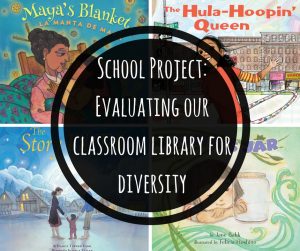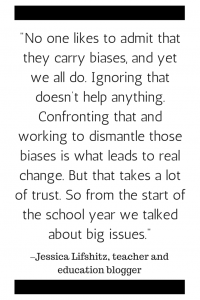![]() Earlier this month, we highlighted the impressive work happening in the classroom of Jessica Lifshitz, veteran educator in Northbrook, Illinois. Following her popular essay on how Jessica empowered her fifth grade students to analyze their classroom library for its culturally responsiveness and relevancy, she shares in this interview with LEE & LOW BOOKS why she wanted to take on this project with her students, where families and administrators fit into this process, and her hopes for her students.
Earlier this month, we highlighted the impressive work happening in the classroom of Jessica Lifshitz, veteran educator in Northbrook, Illinois. Following her popular essay on how Jessica empowered her fifth grade students to analyze their classroom library for its culturally responsiveness and relevancy, she shares in this interview with LEE & LOW BOOKS why she wanted to take on this project with her students, where families and administrators fit into this process, and her hopes for her students.
LEE & LOW: What inspired you to have your students analyze your classroom library?
After the events surrounding the shooting and death of Michael Brown in Ferguson, I felt compelled to find a way to bring more discussions on race into my classroom. I teach in a suburb of Chicago, where the vast majority of my students are white. There were little or no conversations about race at all taking place. I knew that if things were going to ever have a hope of getting better in this country, my mostly white students HAD to be a part of the solution. They had to recognize the bias that exists in this country and then find a way to fight against it. But that is really hard to do when the concept of race is not one that my students have had much, if any, experience dealing with. So, like with most problems, the first place that I looked to try and find a solution was with the very books that make up a huge part of the work that my students and I do together.
country, my mostly white students HAD to be a part of the solution. They had to recognize the bias that exists in this country and then find a way to fight against it. But that is really hard to do when the concept of race is not one that my students have had much, if any, experience dealing with. So, like with most problems, the first place that I looked to try and find a solution was with the very books that make up a huge part of the work that my students and I do together.
We began by doing a small experiment (explained here) where we looked only at the images on the covers of picture books and made predictions on what those books would be about. Based on our results, we realized that we made MANY predictions because of the race and gender of the people shown on the covers of those books. After a powerful discussion with my students, they crafted the following inquiry question: Where do the biases and stereotypes we carry around related to gender, race, family structure, religion, etc. come from?
We then set out to try and answer that question. This eventually led us to think about the picture books in our classroom and that led us to the work of analyzing our books to look at how they represented or misrepresented different groups of people.
So the short answer really is that this work was inspired by students and the conditions of the world that they are living in.
LEE & LOW: Why do this at all? This project is not a part of the curriculum or scope & sequence for fifth grade—why did you think this was important enough to use instructional time?
As teachers, we have an incredible opportunity to truly make the world a better place. Not to sit and wait for others to fix the problems, but to ask our students to join us in the powerful work of actually starting to make the world a better.
I think that a lot of times we waste this amazing opportunity because we feel limited by standards and objectives and curriculum. But what I have found is that if I begin with what work I want my students to be engaged in and then work backwards to connect that work to the standards, I am then able to do the work that I feel is most important AND meet the standards and objectives that I am asked to teach.
For example, the work that we did here was a part of our unit on synthesizing. We looked at how we could pull pieces of information together in order to gain a better, more complete understanding. So we took the issue of stereotypes and biases and that is what we worked to understand. We looked at advertisements, fairy tales, modern day picture books and novels. We pulled all of these pieces of information together to grow our understanding of how biases form. This allowed us to cover many standards and learning targets.
But more importantly, the kids were learning about their world. They were studying the problems that surround them and thinking of ways to begin to solve those problems. That is learning that will last. That is learning that will make a difference. So if I am able to help them to do that kind of work AND I am able to cover the skills I need to teach in the process, then everyone wins and the world gets better.
 LEE & LOW: What foundation, classroom work, or background context do you think was imperative before leading your students through this project?
LEE & LOW: What foundation, classroom work, or background context do you think was imperative before leading your students through this project?
I think that one of the most important pieces of work that allowed this project to happen was that, from day one, we had worked to create a culture of trust in our classroom. We practiced making ourselves vulnerable and we practiced listening to the ideas of others without passing judgments on people. These things were absolutely necessary for our work to take place because part of our work involved sharing things about our own thinking that we weren’t necessarily proud of. No one likes to admit that they carry biases, and yet we all do. Ignoring that doesn’t help anything. Confronting that and working to dismantle those biases is what leads to real change. But that takes a lot of trust. So from the start of the school year we talked about big issues.
We began with during our unit on memoirs and on making connections to the texts that we read. These units became a chance to study the power of a person’s story. We learned the power of sharing our own stories and the power of learning from the stories of others. This work allowed my students to open up to each other about their own lives and also allowed us to practicing listening to people whose lives are very different than our own in order to learn more about them and build empathy. These were skills we needed for this project as well.
When we started to look at biases and stereotypes, we began first with gender before tackling race. We began by looking at catalogues like Pottery Barn to notice the differences in what was marketed towards girls and what was marketed towards boys. We did work that helped us to distinguish the actual things we observed from the more hidden messages that this sent. We started with gender because I think it is easier for kids to grapple with. It is more concrete. While my students had almost no experience discussing issues of race, they did have some experience discussing issues of
gender. So we started with where they were and then moved on from there. That was really important because I think that if I had just thrown them in to the discussions of how races were misrepresented in the books in our classroom library, they would not have been ready. The work we did with issues of gender helped us to better understand the work we later did with issues of race.
LEE & LOW: For teachers interested in leading their students through similar thinking and analysis, what would you recommend they prepare either for themselves or their students?
I hope that others want to take on similar work and I know that so many already have. The beauty of this kind of work is that is uses materials that are already present in your classroom. We have books and we can all look more closely at those books.
One thing that I would recommend is a whole lot of communication before beginning. I had several conversations with my principal about the work we were taking on. It was never to ask permission to do the work, but instead to just let him know and make sure I had his support in case of any push back from parents. Issues of race often spark fears and concerns with parents and having administrator support makes all of that much easier. On that note, keeping parents informed of the work was also really important for me. I wanted to make sure that parents knew what we were doing so that the conversations we were having could be continued at home. I also made sure to let parents know how our work was connected to our curriculum and our standards and learning targets. Therefore, when questions were asked, I was able to refer back to the information that I had already shared. This was extremely helpful.
Other than communication, I would also just encourage teachers to not say too much. Instead, allow the students observations to drive the conversation. We began by looking at the infographic and then jumped pretty quickly into the data collection in our own classroom library. I have a terrible habit of telling my students all of the things that I want them to discover on their own. I have really had to work to stop myself from doing that because taking away that power from my students takes the learning right out of their hands. So I wouldn’t recommend preparing too much and allowing the students to really guide this work.
LEE & LOW: Is this only valuable for classrooms with a majority of students of color? What can classrooms of various demographic configurations take away from this project?
As I mentioned before, my students are mostly white. Because of that, this work is especially important for them. So often, our white students do not ever think about race. That is part of the privilege they are living with. But that makes it really easy for them to ignore what others have to deal with precisely because of their race. I believe that my students MUST be a part of a solution to the many problems connected to race in this country. But they cannot be a part of that solution if they are not even able to recognize that the problems exist.
For Further Reading:
- Part 1–Having Students Analyze Our Classroom Library To See How Diverse It Is by Jessica Lifshitz
- Why Do We Need Diverse Books in Non-Diverse Schools? by Taun Wright, Equal Read

Jessica Lifshitz is a fifth grade teacher in Northbrook, Illinois and has been teaching for 13 years. She believes in teaching her students that reading and writing can make the world a better place and is honored to learn from her students and to be inspired by them every day. She writes about teaching and learning at crawlingoutoftheclassroom.wordpress.com.








